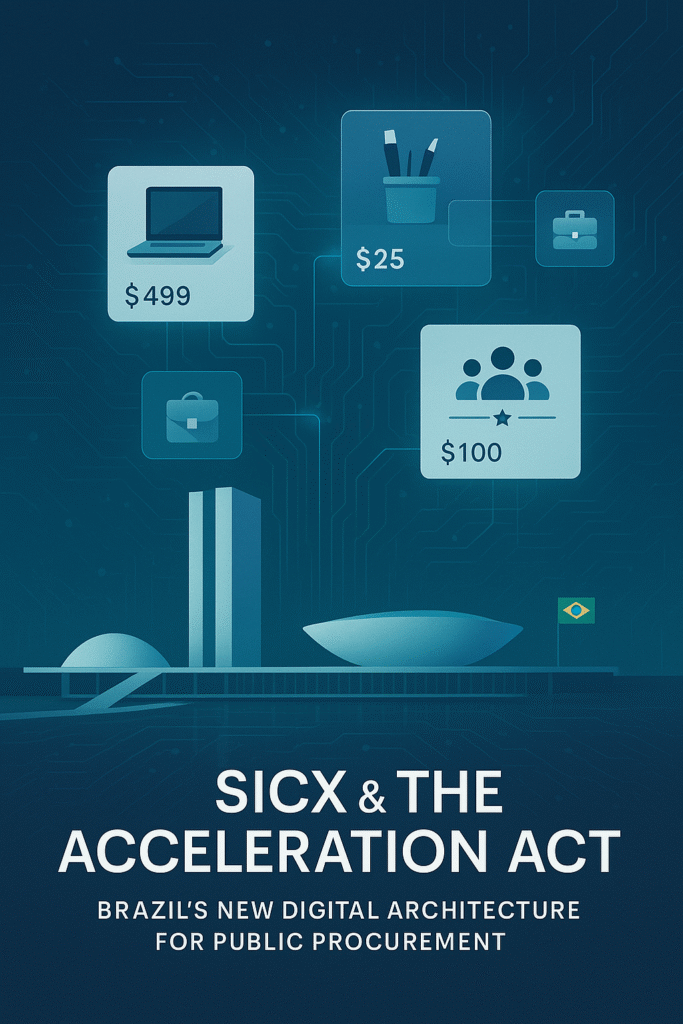Brazil has just taken one of its most significant steps since the new Public Procurement Law (Law 14.133).
With the sanction of Law 15.266/2025, the federal government created the
System of Express Purchases (SICX) — a digital, standardized and
efficiency-driven framework for acquiring goods and services across the public sector.
SICX positions itself as a kind of regulated public “marketplace”: a platform where the State can compare
offers objectively, accelerate purchase cycles and unlock price competition in a way that is
traceable, auditable and compatible with public law constraints.
SICX is not just a new tool — it is an institutional redesign of how the Brazilian State relates to its suppliers,
money and data.
From an innovation and governance perspective, this is a milestone. From a legal standpoint, a silent revolution.
From a societal lens, it is a promise of deploying public funds more intelligently, with less friction and more oversight.
1. What Is SICX? From Analog State to Intelligent State
The System of Express Purchases (SICX) embeds, for the first time,
e-commerce as an official procurement modality under the Public Procurement and Administrative Contracts framework.
In practice, SICX is designed to:
- enable objective comparison of goods and services;
- reduce the duration and cost of procurement cycles;
- discourage artificial price variations and informational asymmetries;
- automate and standardize key phases of the process;
- offer a fully digital, auditable transaction trail.
Senator Fernando Farias, rapporteur of the bill in the Senate, emphasized that SICX will allow more objective
comparison of offers, leading to faster purchase cycles and more competitive pricing.
2. E-Procurement as a Formal Modality
With Law 15.266/2025,
e-commerce is formally recognized as a modality for acquiring standardized common goods and services
in the public sector. This signals a cultural and operational shift:
the State is importing best practices from the private sector while preserving legal safeguards.
Globally, this aligns Brazil with systems such as:
- GSA Advantage (United States),
- KONEPS (South Korea),
- GeM (India).
These platforms became benchmarks not only for digitization, but for a deeper transformation:
using data, competition and automation to govern public spending.
3. Who Is Affected — and How
Public Bodies and Entities
SICX will be available to ministries, agencies, autarchies, foundations, public enterprises, state-owned companies,
their subsidiaries and even non-profit private entities that manage public resources.
Expected benefits include:
- shorter procurement timelines;
- reduction of bureaucratic bottlenecks;
- fewer inconsistencies and redundant procedures;
- enhanced transparency for internal and external control.
Suppliers
For suppliers, especially small and medium-sized businesses, SICX lowers traditional barriers:
- clearer, unified rules;
- digital onboarding through a common registry;
- increased visibility and predictability of opportunities;
- a more level playing field, with standardized conditions;
Society
For citizens and taxpayers, SICX offers:
- more efficient use of public funds;
- better tools to monitor and audit spending;
- reduction of waste and overpricing;
- a tangible bridge between digital government and real-world outcomes.
4. PNCP Integration: The End of Fragmented Registries
The law requires that public bodies and entities use the
unified registry available on the National Public Procurement Portal (PNCP)
for supplier onboarding and maintenance.
This integration:
- reduces duplication of vendor records;
- mitigates the risk of fictitious companies and identity inconsistencies;
- facilitates multi-agency interoperability;
- creates a single backbone for procurement identity management.
SICX is the transactional layer. PNCP is the identity and registry layer.
The Executive, via regulation, will act as the normative and governance layer knitting these together.
5. The Regulatory Layer: Where Success Will Be Decided
While Law 15.266/2025 creates the framework, the Executive branch will define the operational DNA
of SICX through regulations, including:
- criteria for supplier admission and permanence;
- rules for pricing, price adjustments and revisions;
- delivery methods and timelines;
- procedural rules for platform usage;
- payment conditions (with a maximum 30-day term);
- sanctions and enforcement mechanisms for breaches.
These details will determine whether SICX becomes a transformative platform or just another underused government system.
6. Where AI Comes In: From Digital Platform to Intelligent Infrastructure
By design, SICX is a digital platform. Its true transformative capacity will emerge when it is combined with
AI-powered analytics and automation, in areas such as:
- Automatic overpricing detection: comparing prices across time, regions and similar items;
- Supplier risk monitoring: integrating compliance, litigation and reputational data;
- Automatic item classification: reducing errors and ambiguity in descriptions;
- Real-time algorithmic auditing: detecting suspicious patterns and fraud attempts early;
- Demand and price forecasting: improving annual budget planning and contract strategy.
Experiences from tools like the TWS IP AI Tool show how AI can help:
- structure complex data for decision-making;
- generate explainable dashboards and risk reports;
- support compliance-by-design architectures in legal workflows.
7. Risks and Points of Attention
No innovation in public procurement is risk-free. Key concerns include:
- dependence on specific technology vendors;
- use of opaque or non-auditable algorithms;
- digital exclusion of smaller suppliers with limited capabilities;
- data governance failures or cybersecurity incidents;
- uneven adoption among different branches and levels of government.
Mitigation requires:
- strong transparency and reporting obligations;
- robust LGPD-compliant data governance;
- independent audits of systems and algorithms;
- secure software development and infrastructure;
- capacity-building for procurement teams and oversight bodies.
8. 2025–2030: Can Intelligent Procurement Become a Growth Engine?
Public procurement accounts for a significant share of Brazil’s GDP.
If well implemented, SICX can:
- increase competition and market access;
- unlock productivity gains;
- improve government efficiency;
- stimulate innovation ecosystems across Brazil;
- create a transparent, data-driven procurement culture.

